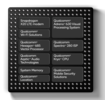Qualcomm Snapdragon 850 vs Qualcomm Snapdragon 685 4G
Qualcomm Snapdragon 850
► remove from comparison
The Qualcomm Snapdragon 850 Mobile Compute Platform (or SD850) is a ARM based SoC for Windows laptops. It is a higher clocked version (3 versus 2.8 GHz) of the Snapdragon 845 for smartphones and also manufactured in 10 nm LPP FinFET at TSMC. It integrates 4x Kryo 385 cores (Cortex-A75) at up to 2.95 GHz (max) for performance and 4x Kryo 385 (at 1.8 GHz?) for efficiency. Furthermore offers an X20 LTE modem (Cat. 18 1.2 Gbps downlink, Cat 13 150 Mbps uplink), ac-WiFi and a dual-channel 32-Bit 1866 MHz LPDDR4x memory controller.
The performance of the Snapdragon 850 in Windows is in theory similar to a Intel Core i5 of the Y-series (e.g. Core i5-7y54). However, this is only the case for native ARM64 compiled applications and games. 32-bit applications that are not compiled for the ARM architecture only run in an emulation and perform much worse (e.g. see Cinebench R11.5 benchmark). 64-bit Intel/AMD apps are not supported at all.
The chip is very power efficient as its produced at TSMC in the modern 10nm LPP process. Therefore, laptops using the Snapdragon 850 can be passively cooled (no fan) and should not throttle under constant load.
Qualcomm Snapdragon 685 4G
► remove from comparison
The Qualcomm Snapdragon 685 (SD685, SM6225-AD) is a mid-range ARM-based SoC largely found on Android tablets and smartphones. It features 8 Kryo 265 cores (custom design, 64-Bit capable) that are divided in two clusters. A fast cluster of four cores with up to 2.8 GHz (Kryo 265 Gold - Cortex-A73 derivate) and a power saving efficiency cluster with up to 1.9 GHz (Kryo 265 Silver - Cortex A53 derivate). Both clusters can also be used together. According to Qualcomm the SD685 is around 15% more CPU performance and 10% more GPU performance compared to the old SD680 (thanks to higher clock speeds).
In addition to the 8 CPU cores, the SoC integrates a mid range Adreno 610 GPU with a LPDDR4 memory controller (dual-channel) and supports Wi-Fi (802.11ac + MIMO, max. 867 Mbps), Bluetooth 5, and LTE (X11 LTE modem with up to 390 Mbps download).
The SoC is produced in 6nm.
| Model | Qualcomm Snapdragon 850 | Qualcomm Snapdragon 685 4G | ||||||||||||||||
| Codename | Cortex-A75 / A55 (Kryo 385) | Kryo 265 Gold (Cortex-A73) / Silver (Cortex-A53) | ||||||||||||||||
| Series | Qualcomm Snapdragon | Qualcomm Snapdragon | ||||||||||||||||
| Series: Snapdragon Kryo 265 Gold (Cortex-A73) / Silver (Cortex-A53) |
|
| ||||||||||||||||
| Clock | 2750 - 2960 MHz | 1900 - 2800 MHz | ||||||||||||||||
| L1 Cache | 768 KB | |||||||||||||||||
| L2 Cache | 1.5 MB | |||||||||||||||||
| L3 Cache | 2 MB | |||||||||||||||||
| Cores / Threads | 8 / 8 | 8 / 8 | ||||||||||||||||
| Technology | 10 nm | 6 nm | ||||||||||||||||
| Features | X20 LTE Modem, Adreno 630 GPU | Adreno 610 GPU, X11 LTE Modem, Hexagon 686 DSP, Spectra 346 ISP, FastConnect 6200 (BT 5.2, WLAN ac), QuickCharge 3.0 | ||||||||||||||||
| iGPU | Qualcomm Adreno 630 | Qualcomm Adreno 610 | ||||||||||||||||
| NPU / AI | 3 TOPS INT8 | |||||||||||||||||
| Architecture | ARM | ARM | ||||||||||||||||
| Announced | ||||||||||||||||||
| Manufacturer | www.qualcomm.com | www.qualcomm.com |
Benchmarks
Average Benchmarks Qualcomm Snapdragon 850 → 100% n=6
Average Benchmarks Qualcomm Snapdragon 685 4G → 100% n=6
* Smaller numbers mean a higher performance
1 This benchmark is not used for the average calculation












